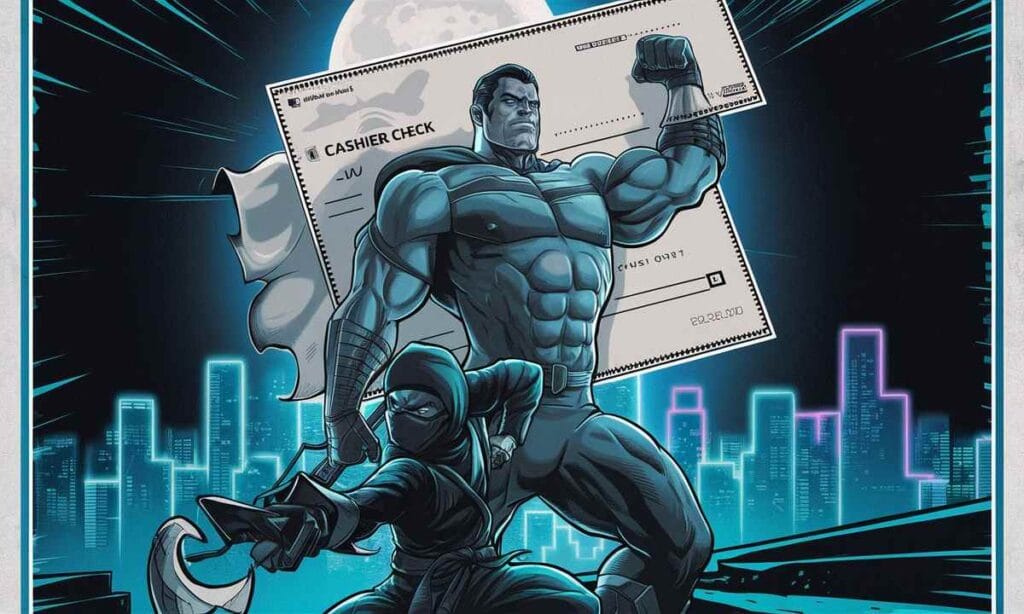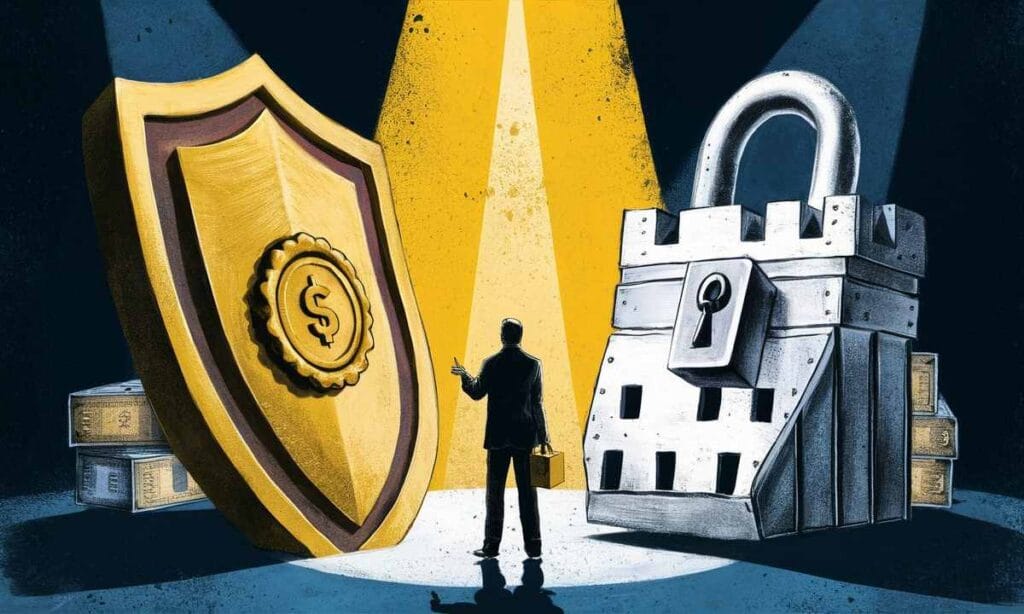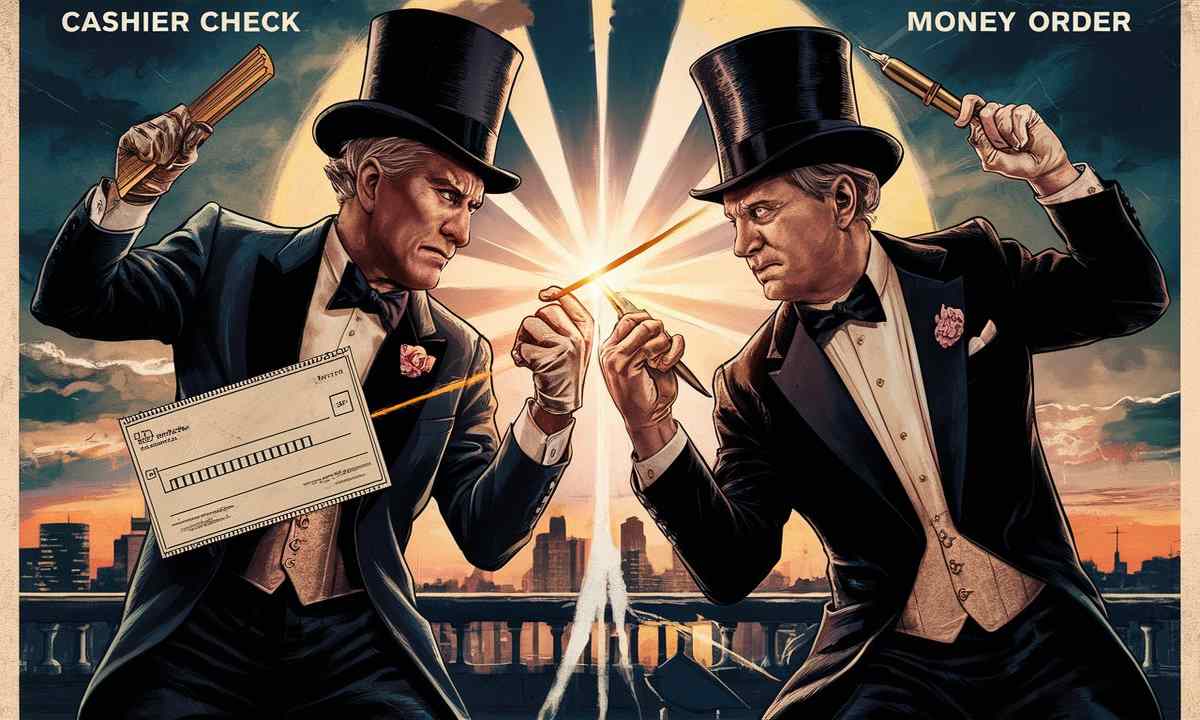Overview of Cashier’s Checks and Money Orders
Cashier’s checks and money orders are both secure financial instruments used to facilitate payments, but they cater to different needs and offer distinct features. A cashier’s check is a guaranteed payment instrument issued by a bank on behalf of the payer, drawing funds from the bank’s own account. Conversely, a Money Order is a prepaid financial product, typically available through various outlets including post offices and retail stores, allowing individuals to make payments without needing a bank account. Understanding the nuances between these two payment methods is crucial for selecting the most appropriate option for different financial transactions.

Importance of Understanding the Differences
Choosing between a Cashier’s Check and a Money Order can significantly impact the security, cost, and efficiency of a transaction. Misunderstanding these differences may lead to delays, additional fees, or even transaction failures. By delving into the specifics of each instrument, individuals and businesses can make informed decisions that align with their financial needs and circumstances. Whether you’re dealing with large payments or routine transactions, comprehending these distinctions ensures smoother and more reliable financial dealings.
What is a Cashier’s Check?
Definition and Purpose
A cashier’s check is a type of check guaranteed by a bank, which draws on the bank’s own funds rather than the payer’s account. This makes it a reliable and secure form of payment, as the bank assumes responsibility for the funds. Cashier’s checks are commonly used for transactions that require a guaranteed payment, such as real estate purchases or large-scale transactions where trust and verification are paramount.
How Cashier’s Checks are Issued
To obtain a cashier’s check, an individual must request it from their bank. The payer provides the bank with the amount of the check plus any applicable fees. The bank then issues the check, which is drawn from its own funds and includes the payer’s information and the recipient’s details. The bank’s involvement in the process assures the recipient of the check’s validity, as the funds are guaranteed by the bank.
Typical Uses for Cashier’s Checks
Cashier’s checks are often used in high-value transactions where security is essential. Common scenarios include purchasing real estate, making down payments on a car, or settling large bills. They are preferred in situations where the recipient needs assurance that the funds are available and guaranteed, minimizing the risk of bounced checks or insufficient funds.

What is a Money Order?
Definition and Purpose
A Money Order is a prepaid financial instrument that functions similarly to a check but does not require a bank account. It is purchased with cash or a debit card at various locations, such as post offices, retail stores, or financial institutions. Money orders are ideal for individuals who do not have access to traditional banking services or need a secure method of payment that does not involve a personal check.
How Money Orders are Purchased
To purchase a Money Order, the payer provides the amount to be issued plus any associated fees. The payment is made in cash or with a debit card, and the issuer provides a Money Order that includes the payer’s and recipient’s details. The buyer retains a receipt for their records. Money orders are typically limited to lower amounts compared to cashier’s checks, making them suitable for smaller transactions.
Common Uses for Money Orders
money orders are commonly used for personal transactions, such as paying rent, sending money through the mail, or paying bills. They are particularly useful for individuals who do not have bank accounts or prefer not to use personal checks. Additionally, money orders are often used for transactions where the payer wants to avoid the risks associated with cash.
Read More : What is a Cashier’s Check? 20 Questions

Key Features of a Cashier’s Check
Security Measures
Cashier’s checks offer high security due to their bank-backed guarantees. The bank verifies the funds and assumes responsibility for payment, reducing the risk of fraud. Additionally, cashier’s checks often feature various security features, such as watermarks and special paper, to deter counterfeiting and ensure authenticity.
Verification Process
The verification process for a cashier’s check involves confirming its legitimacy with the issuing bank. Recipients can call the bank or use online services to verify that the check is valid and that the funds are available. This process helps prevent fraudulent activities and ensures that the check will be honored.
Cost and Fees
Obtaining a cashier’s check typically involves a fee, which can vary depending on the bank and the check amount. Fees are generally higher than those for money orders due to the added security and bank involvement. It is advisable to check with the bank for the exact fee structure before requesting a cashier’s check.
Processing Time
The processing time for a cashier’s check is relatively short. Once issued, the check can be deposited or cashed almost immediately, assuming the recipient’s bank is able to verify the check. The efficiency of the process makes cashier’s checks suitable for transactions requiring prompt settlement.
Key Features of a Money Order
Security Measures
Money orders offer a moderate level of security. They are prepaid and often require the payer to provide identification when purchased. However, they may not have the same level of bank-backed guarantee as cashier’s checks, making them somewhat less secure for large transactions. Money orders also include security features to help prevent fraud and counterfeiting.
Verification Process
To verify a Money Order, the recipient can use tracking numbers and contact the issuer or the company that sold the Money Order. Verification helps ensure that the Money Order is legitimate and that it has not been reported lost or stolen. While the process is straightforward, it may not be as robust as the verification for cashier’s checks.

Cost and Fees
Money orders generally come with lower fees compared to cashier’s checks. The cost of purchasing a Money Order is influenced by the amount and the issuer. Fees are typically minimal, making money orders an economical option for smaller transactions.
Processing Time
The processing time for money orders is usually swift. Once purchased, money orders can be deposited or cashed relatively quickly. However, the time required for verification and clearance may vary depending on the issuer and the recipient’s bank.
Comparing Security
How Cashier’s Checks Prevent Fraud
Cashier’s checks are designed to prevent fraud through several mechanisms. The involvement of the bank in issuing the check ensures that the funds are available and secure. Additionally, the bank’s stringent verification processes and security features on the check itself reduce the risk of counterfeit or fraudulent activities.
How Money Orders Prevent Fraud
Money orders also include security features to deter fraud, such as unique serial numbers and watermarks. However, since they are prepaid rather than bank-backed, they may be more vulnerable to certain types of fraud. To mitigate risks, buyers should purchase money orders from reputable sources and keep their receipts.
Which Method Offers Better Security?
Overall, cashier’s checks tend to offer better security due to the bank’s guarantee and comprehensive verification process. Money orders provide a reasonable level of security for smaller transactions but may not match the robustness of cashier’s checks for high-value payments.

Cost Considerations
Cashier’s Check Fees and Charges
The fees for cashier’s checks vary by bank and can be influenced by the amount of the check. On average, the cost ranges from $5 to $15. It is important to inquire about the fee structure before requesting a cashier’s check, as costs can affect the overall expense of the transaction.
Money Order Fees and Charges
Money Order fees are generally lower than those for cashier’s checks, with costs typically ranging from $1 to $5. The fee may vary based on the issuer and the amount of the Money Order. This cost efficiency makes money orders a practical choice for smaller transactions.
Cost Comparison
When comparing costs, money orders usually offer a more economical option for smaller amounts, while cashier’s checks are more appropriate for larger sums despite their higher fees. Evaluating the cost relative to the transaction amount and urgency can help determine the most cost-effective choice.

Usage Scenarios
When to Use a Cashier’s Check
Cashier’s checks are ideal for high-value transactions requiring guaranteed payment, such as purchasing real estate, making large deposits, or paying significant bills. Their reliability and security make them suitable for situations where verification of funds is crucial.
When to Use a Money Order
Money orders are best suited for smaller transactions, such as paying utility bills, sending money through the mail, or making personal payments. They are convenient for individuals without bank accounts or those seeking a secure payment method for everyday use.
Suitability for Large Transactions
For large transactions, cashier’s checks are generally more suitable due to their higher security and guarantee of funds. They provide the assurance needed for significant financial exchanges and are accepted by most institutions and businesses.
Suitability for Small Transactions
Money orders are more appropriate for smaller transactions. Their lower cost and availability make them a practical choice for everyday payments. They offer a convenient alternative for individuals who need a secure payment method without the need for a bank account.

Acceptance and Limitations
Where Cashier’s Checks Are Accepted
Cashier’s checks are widely accepted by banks, real estate agents, and businesses. They are recognized as a reliable form of payment and can be used for a variety of transactions, including large purchases and official payments.
Where Money Orders Are Accepted
Money orders are accepted by many businesses, utility companies, and financial institutions. They are commonly used for personal payments and transactions where cash or checks are not preferred. However, some organizations may have limitations on accepting money orders for certain types of transactions.
Maximum and Minimum Amounts
Cashier’s checks typically do not have maximum limits, making them suitable for large sums. Money orders, on the other hand, often have maximum limits set by the issuer, which can vary. For example, many money orders have a maximum amount of $1,000 to $5,000.
International Transactions
Using Cashier’s Checks Internationally
Cashier’s checks can be used for international transactions, but their acceptance may vary depending on the recipient’s country and financial institution
. It is essential to confirm with the receiving party whether a cashier’s check is acceptable and to consider any additional processing requirements.
Using Money Orders Internationally
Money orders are less commonly used for international transactions due to varying acceptance and limitations. However, some international money orders are available through specific issuers and can be used for sending funds across borders.
Differences in International Use
Cashier’s checks generally offer more flexibility for international transactions compared to money orders. Their bank-backed guarantee can provide reassurance in cross-border dealings, whereas money orders may be subject to additional restrictions and limitations.
Obtaining and Issuing
How to Obtain a Cashier’s Check
To obtain a cashier’s check, visit a bank with the necessary funds and identification. Request the check from the bank, specifying the amount and the recipient’s details. The bank will issue the check and deduct the funds from your account or require payment if you do not hold an account with them.
How to Purchase a Money Order
Money orders can be purchased at various locations, including post offices, retail stores, and financial institutions. Provide the payment amount, pay the associated fee, and fill out the required details. Keep the receipt for your records and as proof of purchase.
Requirements for Issuance
For cashier’s checks, you will need to provide identification and sufficient funds. For money orders, identification may be required, and payment must be made in cash or with a debit card. Each issuer may have specific requirements, so it is advisable to check with the provider beforehand.
Cashing and Depositing
Cashing a Cashier’s Check
To cash a cashier’s check, present it at your bank or a bank that issued it. You may need to provide identification and verify the check’s authenticity. The funds can be received as cash or deposited into your account.
Cashing a Money Order
Money orders can be cashed at the issuing office or at various financial institutions. Provide the Money Order and identification to complete the transaction. Some locations may charge a fee for cashing money orders.
Depositing Cashier’s Checks and Money Orders
Both cashier’s checks and money orders can be deposited into bank accounts. Endorse the check or Money Order and present it to your bank. Deposits may be subject to a hold period depending on the amount and the bank’s policies.
Stopping Payment and Refunds
How to Stop Payment on a Cashier’s Check
To stop payment on a cashier’s check, contact the issuing bank immediately. Provide details of the check and the reason for the stop payment request. The bank will typically require documentation and may charge a fee for this service.
How to Stop Payment on a Money Order
Stopping payment on a Money Order involves contacting the issuer with the details of the Money Order and the reason for the request. A stop payment request may require filling out forms and paying a fee. The process may vary depending on the issuer.
Refunds for Lost or Stolen Checks and Money Orders
If a cashier’s check or Money Order is lost or stolen, contact the issuer immediately to report the loss. The issuer will guide you through the process of obtaining a replacement or refund. Documentation, such as a police report or proof of purchase, may be required.
Legal and Financial Considerations
Legal Standing of Cashier’s Checks
Cashier’s checks are considered a legally binding financial instrument with the bank guaranteeing the payment. They are widely recognized and enforceable in legal and financial transactions, offering a high level of security and reliability.
Legal Standing of Money Orders
Money orders are also legally binding but are backed by the issuer rather than a bank. They are enforceable for the amount specified and are recognized for their security features. However, they may not offer the same level of legal backing as cashier’s checks.
Financial Implications of Using Each Method
The financial implications of using cashier’s checks and money orders include considerations of cost, security, and convenience. Cashier’s checks generally involve higher fees but offer greater security for large transactions. Money orders are cost-effective for smaller amounts but may have limitations on use and acceptance.
Pros and Cons
Advantages of Cashier’s Checks
Cashier’s checks offer high security, reliability, and are widely accepted for large transactions. They provide a bank-backed guarantee, reducing the risk of fraud and ensuring that funds are available.
Disadvantages of Cashier’s Checks
The primary disadvantage of cashier’s checks is their higher cost compared to money orders. Additionally, they require a visit to the bank and may involve a waiting period for processing.
Advantages of Money Orders
Money orders are economical, easy to obtain, and do not require a bank account. They offer a secure payment method for smaller transactions and are widely available at various locations.
Disadvantages of Money Orders
Money orders have lower maximum limits and may not be accepted for large transactions. They also offer less security compared to cashier’s checks and may be subject to additional verification processes.
Choosing the Right Method
Factors to Consider for Cashier’s Checks
When choosing a cashier’s check, consider the amount of the transaction, the level of security required, and the associated fees. Cashier’s checks are suitable for high-value transactions where bank-backed guarantees are crucial.
Factors to Consider for Money Orders
For money orders, consider the transaction amount, cost efficiency, and ease of purchase. Money orders are ideal for smaller transactions and are a practical choice for individuals without bank accounts.
Decision-Making Guide
To decide between a cashier’s check and a Money Order, evaluate the transaction size, urgency, cost, and security needs. For high-value, secure transactions, a cashier’s check is generally preferable. For smaller, cost-effective payments, a Money Order is often sufficient.
BOTTOM LINE
Summary of Key Differences
Cashier’s checks and money orders each offer unique advantages and are suited to different types of transactions. Cashier’s checks provide a higher level of security and are ideal for large transactions, while money orders offer cost efficiency and convenience for smaller payments.
Final Recommendations for Use
Selecting between a cashier’s check and a Money Order depends on the specific needs of the transaction. For high-value and secure payments, cashier’s checks are recommended. For everyday transactions or when cost is a factor, money orders are a viable alternative.
Frequently Asked Questions (FAQs)
Which is safer: a Cashier’s Check or a Money Order?
A Cashier’s Check is generally considered safer than a Money Order. Cashier’s checks are backed by the bank’s funds and involve stringent verification processes to prevent fraud. Money orders, while secure, are not backed by a bank, and their security features are less comprehensive. For more information on this topic, you can refer to this source.
How can you get a Cashier’s Check?
To obtain a Cashier’s Check, you need to visit your bank or credit union with the necessary funds and identification. Request the check from the bank, specifying the amount and the recipient’s details. The bank will issue the check and deduct the funds from your account or require payment if you do not hold an account with them.
Where can you purchase a Money Order?
Money orders can be purchased at various locations, including post offices, retail stores, and financial institutions. Major outlets such as supermarkets, convenience stores, and drugstores often provide Money Order services.
Are cashier’s checks or money orders more expensive?
Cashier’s checks are typically more expensive than money orders. Fees for cashier’s checks generally range from $5 to $15, while Money Order fees are usually between $1 and $5. The cost difference reflects the additional security and bank involvement associated with cashier’s checks.
Can a Money Order be cashed or only deposited?
A Money Order can be both cashed and deposited. It can be cashed at the issuer’s office or at financial institutions that accept money orders. Additionally, it can be deposited into a bank account, similar to a check.
How long does it take to get a Cashier’s Check?
A Cashier’s Check is usually available immediately or within a short period after your request, depending on the bank’s processing time. Most banks can issue a Cashier’s Check on the same day you request it.
Is there a limit on the amount for a Cashier’s Check or Money Order?
Cashier’s checks generally do not have a maximum limit, making them suitable for large transactions. Money orders often have maximum limits, which can range from $1,000 to $5,000, depending on the issuer.
What should you do if a Cashier’s Check is lost or stolen?
If a Cashier’s Check is lost or stolen, you should immediately contact the issuing bank to report the loss. The bank will guide you through the process of stopping payment and issuing a replacement, which may involve providing proof of the loss or theft.
Can you use a Money Order for online transactions?
Money orders are typically used for in-person transactions or sent through the mail. They are not commonly used for online transactions due to their physical nature and limitations in digital processing.
Are there fees associated with cashing a Money Order?
Yes, some financial institutions may charge a fee for cashing a Money Order. The fee amount can vary depending on the issuer and the location where you are cashing the Money Order.
What are the security features of a Cashier’s Check?
Cashier’s checks include several security features such as watermarks, microprinting, and special paper to prevent counterfeiting. The involvement of the issuing bank also adds a layer of security, as the bank guarantees the funds.
Can a Money Order be used for international payments?
Some money orders are available for international payments, but they are less commonly used for this purpose compared to other methods. For international transactions, options like wire transfers or international checks may be more suitable.
How can you verify the authenticity of a Cashier’s Check?
To verify the authenticity of a Cashier’s Check, contact the issuing bank directly and provide the check details for confirmation. The bank can confirm whether the check is genuine and if the funds are available.
Can you stop payment on a Cashier’s Check or Money Order?
Stopping payment on a Cashier’s Check is possible by contacting the issuing bank. For money orders, you must contact the issuer to request a stop payment, which may involve filling out forms and paying a fee.
What are the benefits of using a Cashier’s Check over a Money Order?
The primary benefits of a Cashier’s Check over a Money Order include higher security due to bank guarantees, no maximum limit on amounts, and broader acceptance for large transactions. Cashier’s checks provide greater assurance for significant payments.
How do you fill out a Money Order correctly?
To fill out a Money Order, write the recipient’s name in the designated payee field, include your name and address in the purchaser section, and enter the payment amount. Sign the Money Order on the front where indicated and keep the receipt for your records.
Are cashier’s checks and money orders refundable?
Cashier’s checks and money orders can be refunded under certain conditions, such as loss or theft. You must contact the issuing bank or issuer to request a refund, which may require documentation and proof of the situation.
Can you buy a Cashier’s Check with a credit card?
Generally, you cannot buy a Cashier’s Check with a credit card. Most banks require payment for cashier’s checks to be made using cash, debit cards, or funds from a bank account.
What should you consider when choosing between a Cashier’s Check and a Money Order?
When choosing between a Cashier’s Check and a Money Order, consider factors such as the transaction amount, security needs, cost, and acceptance. Cashier’s checks are better for high-value transactions requiring bank-backed guarantees, while money orders are suitable for smaller, cost-effective payments.









